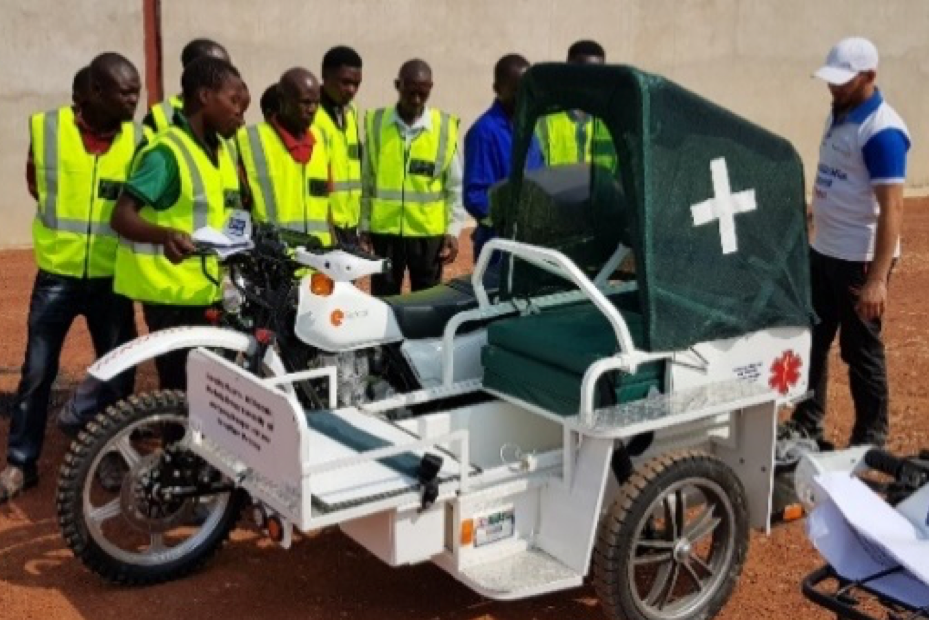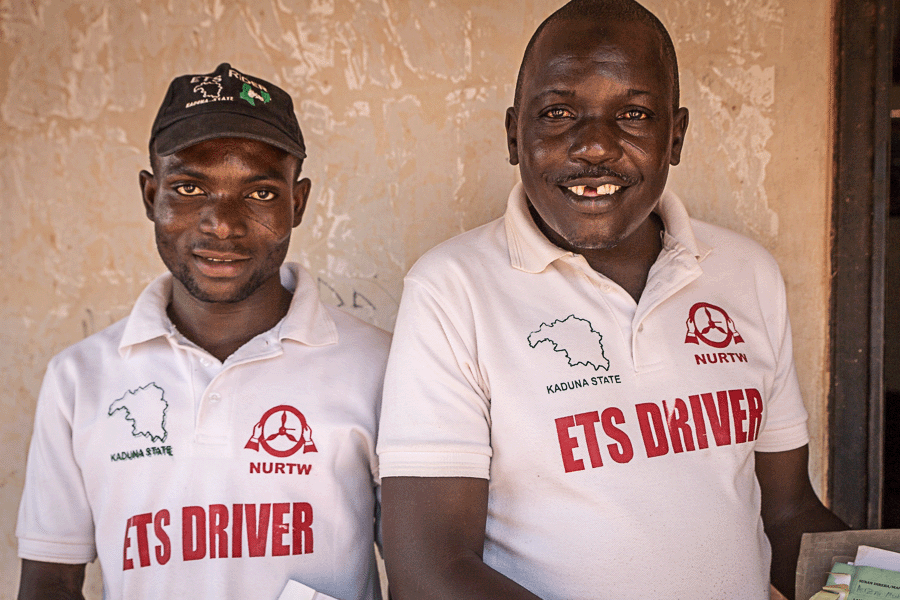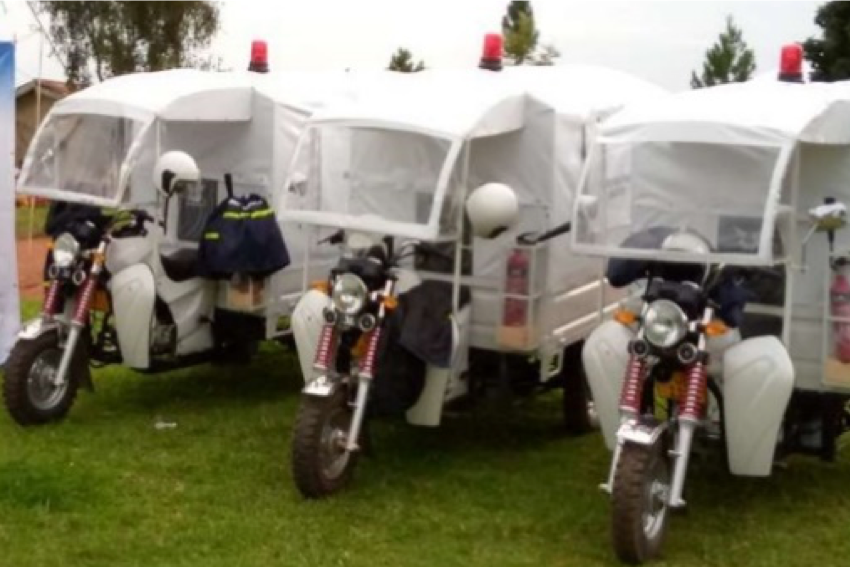COVID-19 has put an unprecedented strain on health systems, often disrupting routine services, including emergency transportation. CHAI has worked with communities to provide sustainable ambulance alternatives since 2011. The pandemic has made these services even more important.
The absence of functional emergency transport systems (ETS) in sub-Saharan Africa was a barrier for patients even before the pandemic. Ambulance services are often unable to cover rural communities. Poor roads and long distances between health centers and villages only compound the problem – especially during obstetric emergencies. An ambulance can mean the difference between life and death for women and newborns who are having birth complications.
Ambulance services have become even more overburdened since the World Health Organization (WHO) declared COVID-19 a global pandemic in March.
In addition to transporting coronavirus patients and frontline health workers, ambulances are, in some cases, being used to send sample shipments or support contact tracing. Invariably, ambulances are less able to respond to maternal and newborn complications or support routine deliveries, especially in hard-to-reach communities.
CHAI’s approach emphasizes community acceptance and ownership to ensure ETS programs are sustained well beyond our involvement.
In addition, countrywide lockdowns have restricted movement and limited the availability of public transportation. A permit is required for movement in some countries, further complicating access to care during emergencies. There are growing concerns of a potential increase in home births as a result of reduced access to emergency transportation, amongst other issues.
A well-run, community-led ETS can address these barriers during the pandemic – and beyond.
CHAI’s approach to setting up community emergency transport systems
As part of CHAI’s Maternal, Newborn and Reproductive Health program in Ethiopia, Nigeria, Zambia, and Uganda, CHAI works with government ministries, communities, transport unions and other partners to design and pilot community-owned and managed systems using motorbike ambulances (MBAs) and other public-private transportation initiatives to move patients and strengthen referral systems.
CHAI’s model emphasizes community acceptance and ownership to ensure the programs are sustained well beyond our involvement. Volunteer emergency transport drivers and riders work with first responders in their communities to ensure 24/7 emergency coverage.
More: Practical considerations for setting up community ETS using motorbike ambulances

Volunteer MBA riders in Northern Province, Zambia, receive training.
Value of community ETS during COVID-19
There have been several documented accounts of these systems saving lives in a number of African countries before the pandemic. A well-managed ETS represents a valuable resource when ambulance services are not available, there are disruptions to public transportation services, or even restrictions in movement.
Throughout the pandemic, ETS drivers and motorcycle riders in Nigeria, Zambia, and Uganda continue to save lives by volunteering their time to transport women and newborns and sometimes the wider population to the nearest health facilities during emergencies. Residing in the communities in which they operate, community transport systems are closer to patients during an emergency and operated by people who understand the local terrain and culture. The volunteers are trusted and recognized by community leaders, patients, and local police. They are also easily distinguished, with ID cards, vehicle stickers and T-shirts/hats that can help them to continue to move quickly during times of restricted movement.

These ETS drivers in Kaduna, Nigeria, are easily identified by their uniforms.
Deploying community motorbike ambulances (MBAs)
Community owned and managed MBAs provide transport to the nearest health facility during an emergency. MBAs are purpose-designed or modified motorcycles and tricycles with a side or back mounted stretcher. Trained volunteer riders operate the vehicles to safely and comfortably transport patients and accompanying responders. With MBAs coming in varying models, prices and quality, CHAI has extensively scoped the market to support an affordable, local, and sustainable supply.
The deployment approach is critical to ensuring ownership and sustained operations.
Recently, in Uganda, locally manufactured MBAs were deployed to communities as part of CHAI’s program. This eliminated shipping costs, saved time, and improved sustainability by making training, maintenance, and replacement parts available locally.
Based on our experiences deploying close to 400 CHAI- and government-procured MBAs in Africa, CHAI has designed a phased holistic and sustainable approach to deploying MBAs. This approach is hinged on a number of supply and demand considerations, including community engagement, oversight, an emergency identification system for trained first responders, timely and functional transport, linkage to health facility networks, protocols, documentation and seamless communication across all levels.
Enabling partnerships with transport unions to establish ETS
CHAI’s community ETS model engages with established private systems, such as taxi unions, to complement ambulance services. Public/private partnerships between communities and local transport unions can bridge community level emergency transport gaps. Trained union members volunteer their vehicles and time during emergencies to transport women and their newborns to the nearest health facility at little or no cost, instead receiving non-financial incentives such as local recognition. For example, in Nigeria CHAI worked with the National Union of Road Transport and National Commercial Tricycle and Motorcycle Owners and Riders Association of Nigeria to expand coverage of their Emergency Transport Scheme.

Locally manufactured motorcycle ambulances deployed in Kibaale District, Uganda.
Community emergency transport systems can save lives when implemented using a holistic and sustainable approach with strong emphasis on local ownership and sustainability. As part of our wider Maternal, Newborn, and Reproductive Health program CHAI continues to expand sustainable and contextually appropriate ETS model across sub-Saharan Africa.
With continued training and recognition, and provision of personal protective equipment and vehicle disinfectants, community volunteers and emergency transport systems can continue be a valuable lifesaving asset for pregnant women and newborns at the community level during critical times like the COVID-19 pandemic.





